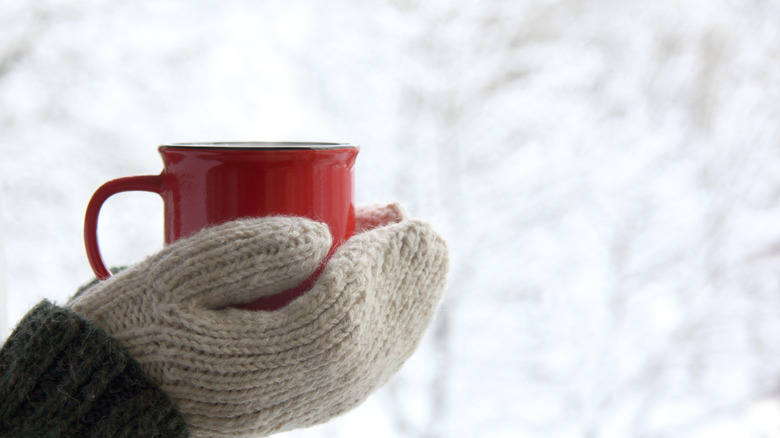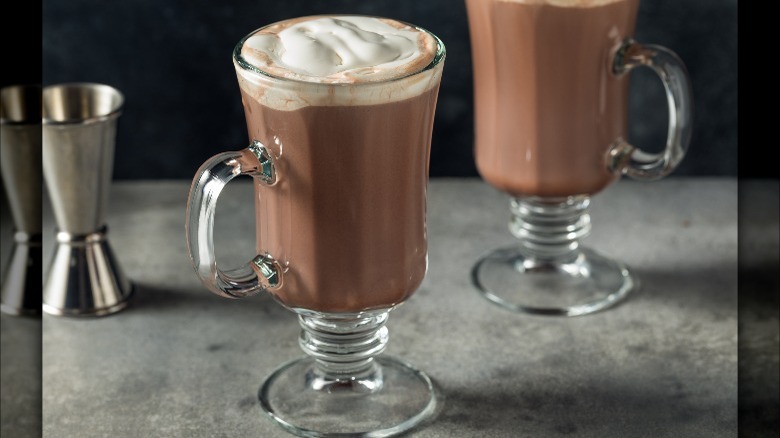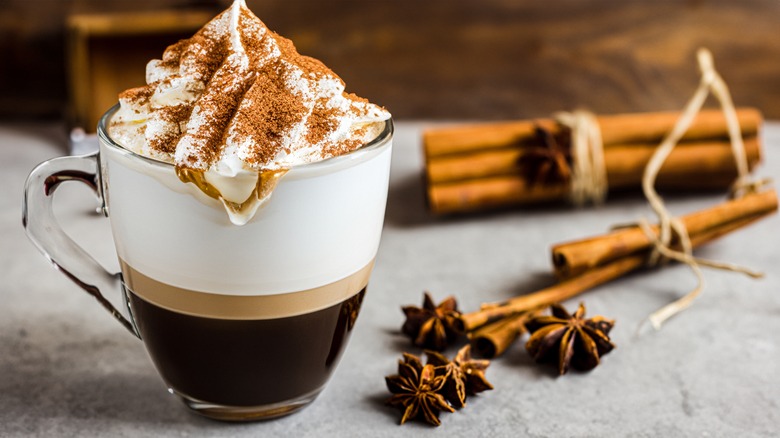The Snowy Origins Of The Green Chaud Cocktail
Despite how savvy cocktail drinkers have become about their booze, the average drinker may not have a full grasp of the verdant and versatile French liqueur green Chartreuse and its long history (and recent scarcity). And while the spirit is used in drinks like The Last Word, Bijou, and Alaska, it's not likely as common as similarly herbaceous bar entries like Grand Marnier, St. Germaine, or Chambord.
But you'd be hard-pressed to find a human who hasn't tried—and loved—a mug of comforting hot chocolate on a cold day. When combined, this complex and powerful green spirit brings an alcoholic bite, along with unique flavor and depth, to the sweet and nostalgic cocoa drink. And though it's no surprise that this delicious pairing has become popular worldwide, how these two liquids came to live in the same mug under the moniker green chaud — or Verte Chaud, meaning "hot green"—is a bit more mysterious, but likely has origins in snowy, high altitudes.
Authenticity and marketing
One can follow the origin story of hot chocolate all the way back to 500 B.C. when Mayans ground cacao beans and combined them with water; later, the drink found its way to Europe in the 17th century. The production of Chartreuse was initiated by Carthusian monks in the Kingdom of France in the 18th century. It seems entirely possible then, that particularly in the frigid winters in the French Alps, chilly travelers would combine the two beverages for a warming superpower.
And while romantic stories circulate, there is hard evidence in the form of a recipe on the bottle pointing to the fact that it was more likely a much more recent creation courtesy of the Chartreuse sales team in the 1980s. Still, there's no denying its legacy is related to apres-ski culture. A 1980s Welsh newspaper encouraged skiers to enjoy this wintry drink, while less than a decade later, a Canadian publication echoed the same sentiment. By the 2010s, New York City was in on the action and the drink found its way into wintery celebrations in the East Village's La Plaza Cultural Park, where Tim Masters (vice president of spirits for Chartreuse's U.S. distribution company) encouraged local bartenders to spread the word about green chaud. Today, while you can still find the cocktail in France, its reach transcends far beyond, and it's a common addition to cocktail menus in colder months.
Why it's delicious, and how to make it your own
The drink may sound a little unusual, but in practice, it makes total culinary sense. The intensely alcoholic green Chartreuse (which clocks in at 55% ABV or 110 proof, as compared to its cousin, yellow Chartreuse, which is 43%) is balanced by bitter chocolate and silky cream. The spirit, which is well-known for leveraging more than 130 herbs, spices, and botanicals for its unique flavor profile, proffers notes of mint, citrus, and pine — all of which pair beautifully with chocolate.
The ratio is up to you, but many recipes call for three parts hot chocolate to one part Chartreuse. Like any cup of cacao, a garnish of fresh vanilla whipped cream is never unwelcome, nor are bittersweet chocolate shavings to top it all off. Spices like cinnamon and anise pair well with both the cocoa and the liqueur. You can also experiment with peppermint hot chocolate, or even opt for a spicy version that includes Mexican hot chocolate, tequila, hot sauce, and dried ancho chili if you aren't convinced you'll be able to stave off the cold. Regardless of its origins, you'll be building on this cocktail's snowy history with every sip.


